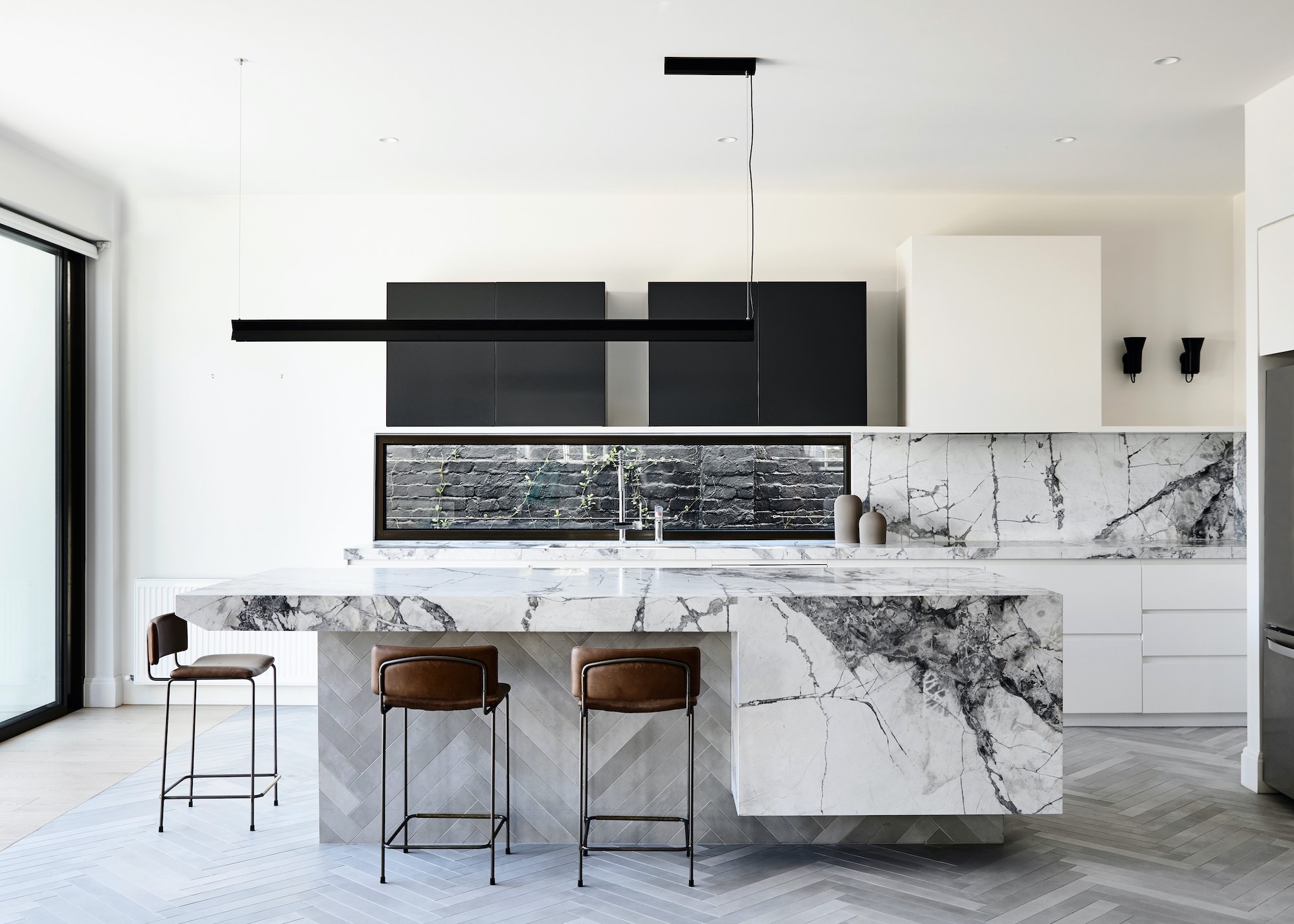
No kitchen focal point hits quite like a marble island. Whether it’s giving Greek-goddess glam with rippling veins or pure modernist energy in slick, sculptural form, marble is the material du jour if you’re seeking luxe looks with the guarantee of timeless appeal (and you should be).
But while marble certainly appears effortlessly high-end, and can indeed elevate the dullest of cabinets, it’s not completely foolproof. You will need to be savvy about how you use it to ensure maximum reward for your investment. Oh, and you should also properly understand what you’re signing up for. Marble isn’t the smartest choice if you’re OCD about scratches and stains.
Setting all that sensible stuff aside, we’ve rounded up a few marble kitchen island ideas to help you focus on the many upsides of nature’s finest crop — from fluting to waterfall drops, unexpected edge profiles and colour-matched schemes that bring the whole space together. Get ready to screenshot your faves and flood your marble island Pinterest board now.
1. Wrap It Around With a Waterfall Edge Marble Island
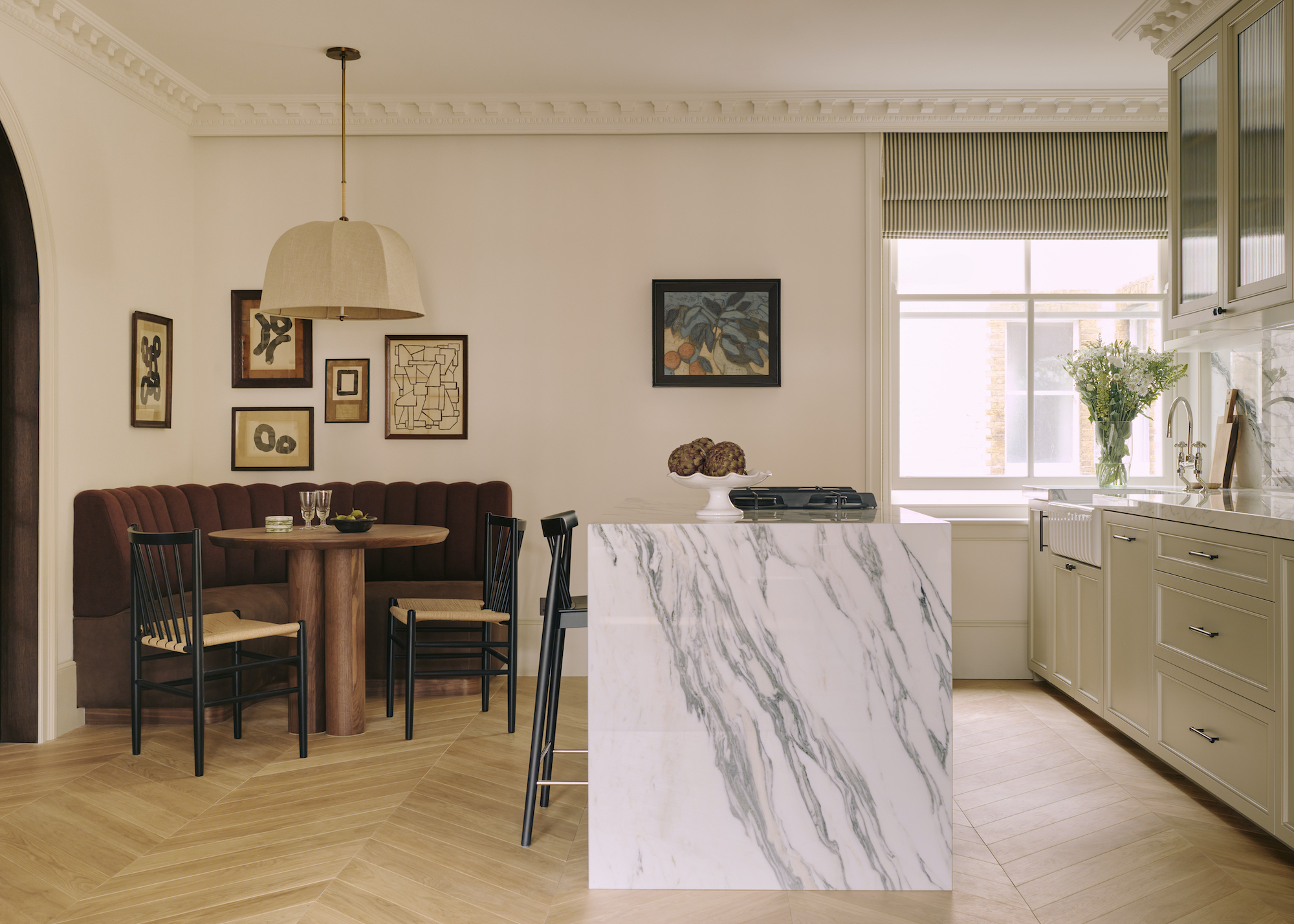
A waterfall countertop marble island is one of those design moves that always looks considered, and never gets old. In this kitchen by De Rosee Sa, it takes centre stage in the most understated way.
“The marble-topped island was a key feature in the kitchen, designed to feel timeless and quietly luxurious,” says senior project architect Claire Mannings. The team chose Arabescato Corchia for its soft veining and refined feel — subtle enough to suit the calm, tonal palette, but striking enough to anchor the space. “The client wanted a neutral stone that would work with the calm palette of whites and greys, but with enough substance to create a focal point,” she explains.
The 50mm countertop thickness and seamless wraparound edge work together to create visual weight and continuity. “The waterfall edge allowed the veining to wrap around seamlessly, highlighting the craftsmanship in the detailing,” adds Claire.
2. Add Some Texture

Fully cladding your island in marble might sound totally dreamy, but without the right detailing, it can end up looking more like a giant block than a luxe statement. One brilliant fix is fluting. Here, the island was clad in Calacatta Vagli Oro — a bold, veined marble that feels elegant, crisp, and clean.
“The addition of fluting along the vertical surfaces introduces texture and depth, breaking up the expanse of stone and adding a sculptural element that catches the light beautifully,” says Oli Webb, director at Cullifords. The fluting not only prevents the island from feeling too ‘monolithic’ but also gives it an artisanal, crafted edge. “It’s a detail that elevates the overall aesthetic while enhancing the natural beauty and tonal variation of the marble,” says Oli.
3. Give It Some Edge

If you want your marble island to stand out from the crowds, without shouting like a banshee, try exploring interesting decorative edges. A subtle profile tweak can completely shift the look, and this Arabescato-topped island is exactly what we’re talking about. “This full-round edge repeated twice is called a double bullnose,” explains Shona McElroy of Smac Studio. “To make it, the stonemason gives the top and bottom pieces of marble a full round edge and then places a 20mm band of marble in between.”
The result is a soft, sculptural detail that adds charm and classic appeal to an otherwise sleek slab of stone. “A double bullnose softens the hard edges of a marble-topped island and makes it look very classic. It’s detailed and pretty,” adds Shona. It’s a small move with big rewards, and a great way to personalise your stone choice while showing off top-notch craftsmanship.
4. Spread the Marble Across the Room
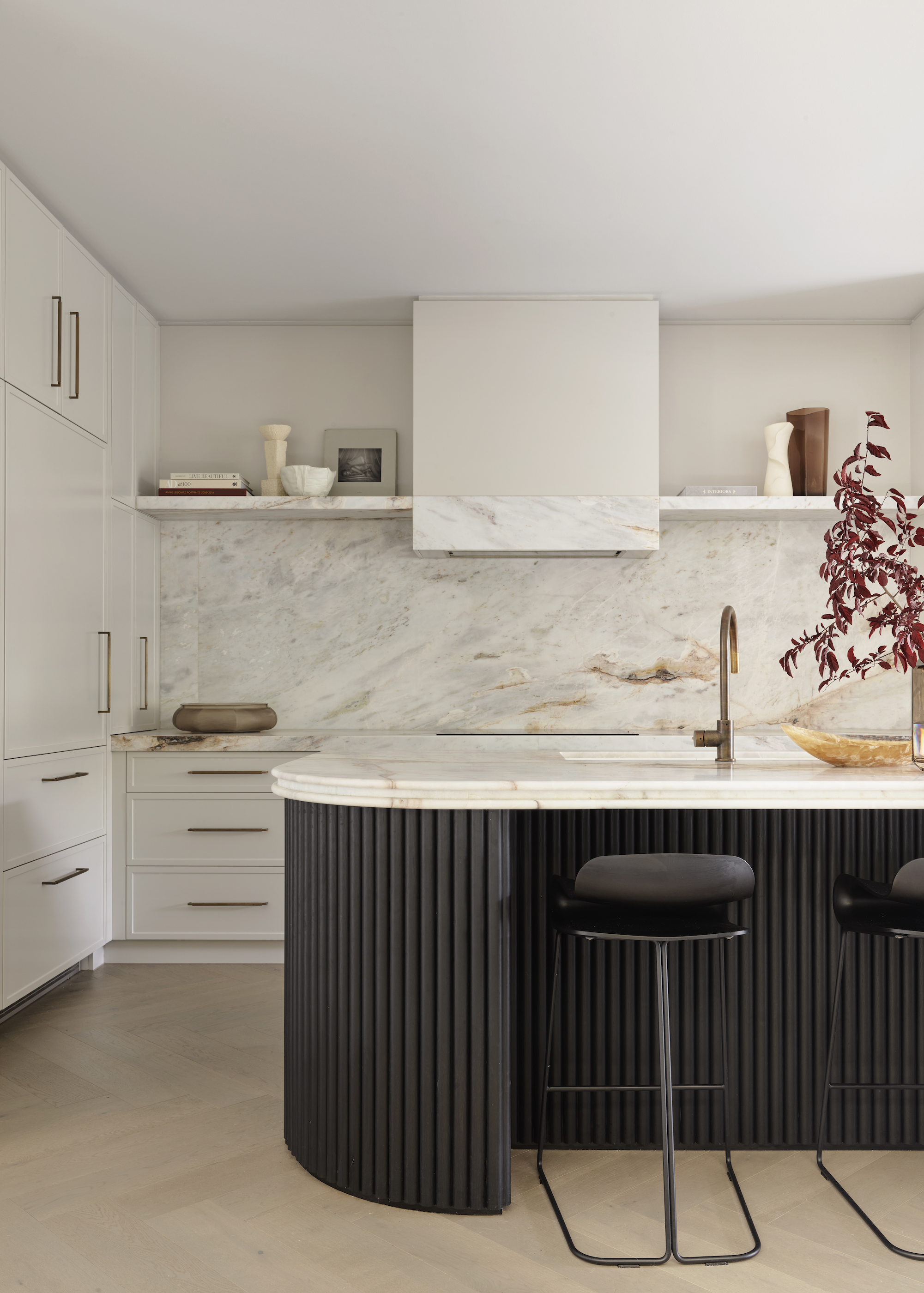
Stopping your marble game at the island can be a missed opportunity. Carrying your marble up onto walls and detailing is a far better way to dine out on all that marble goodness — and this Palladium marble-clad scheme by Smac Studio is solid proof. The creamy stone wraps around the island, then climbs the splashback, trims the rangehood, and even forms floating shelves for a look that feels rich, layered, and super considered.
“It was a very conscious design decision to extend the marble up to the rangehood and shelving. We created datum lines throughout that kitchen, so everything very intentionally lines up,” recalls Shona McElroy of Smac Studio.
The hard work and laser-level action paid off with a seamless, cohesive design that draws your eye across the modern kitchen and ties everything together. It’s all about treating marble as part of the architecture, not just a surface, and it can make your kitchen feel seriously luxe without being flashy.
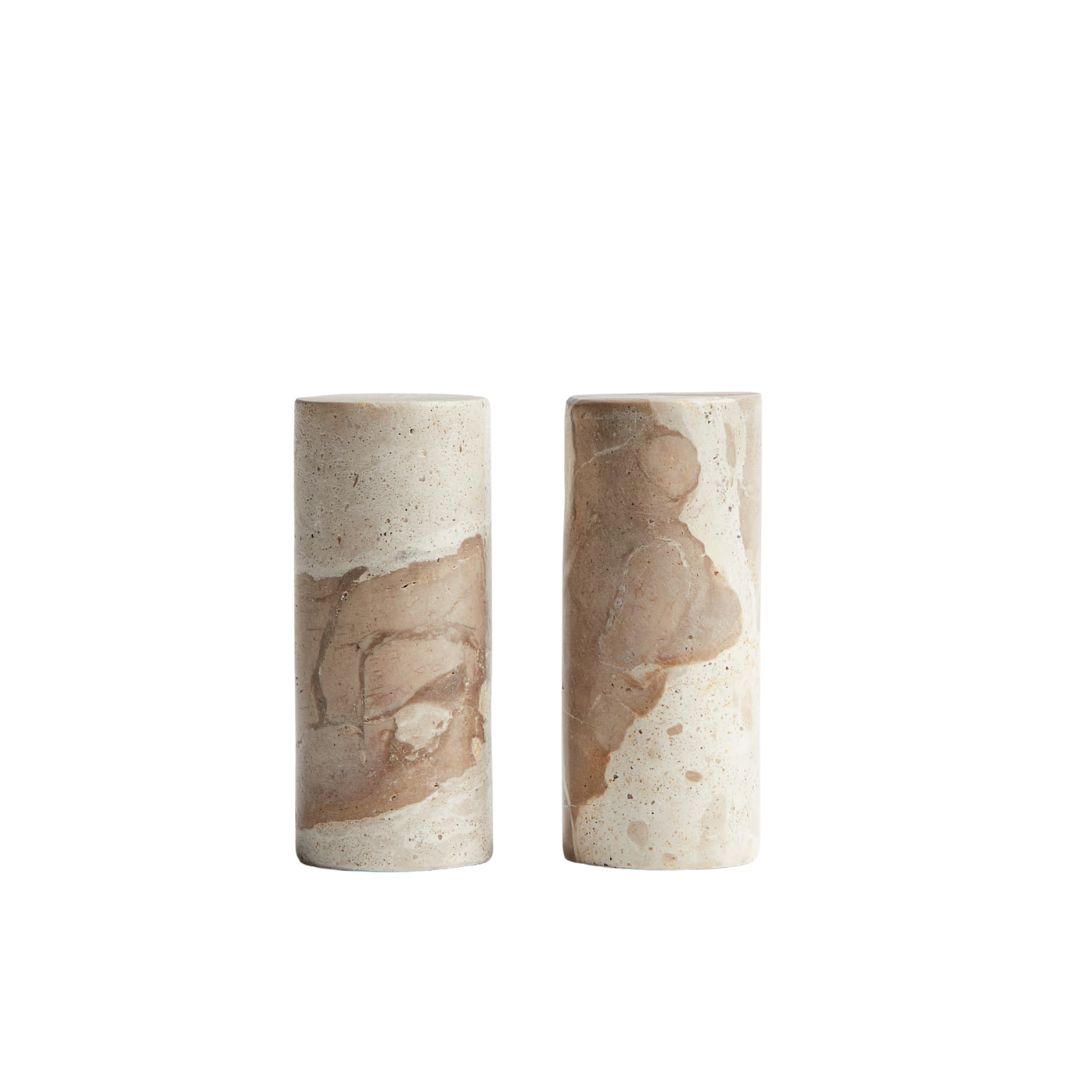
Color: Greige
5. Dare to Go Dark
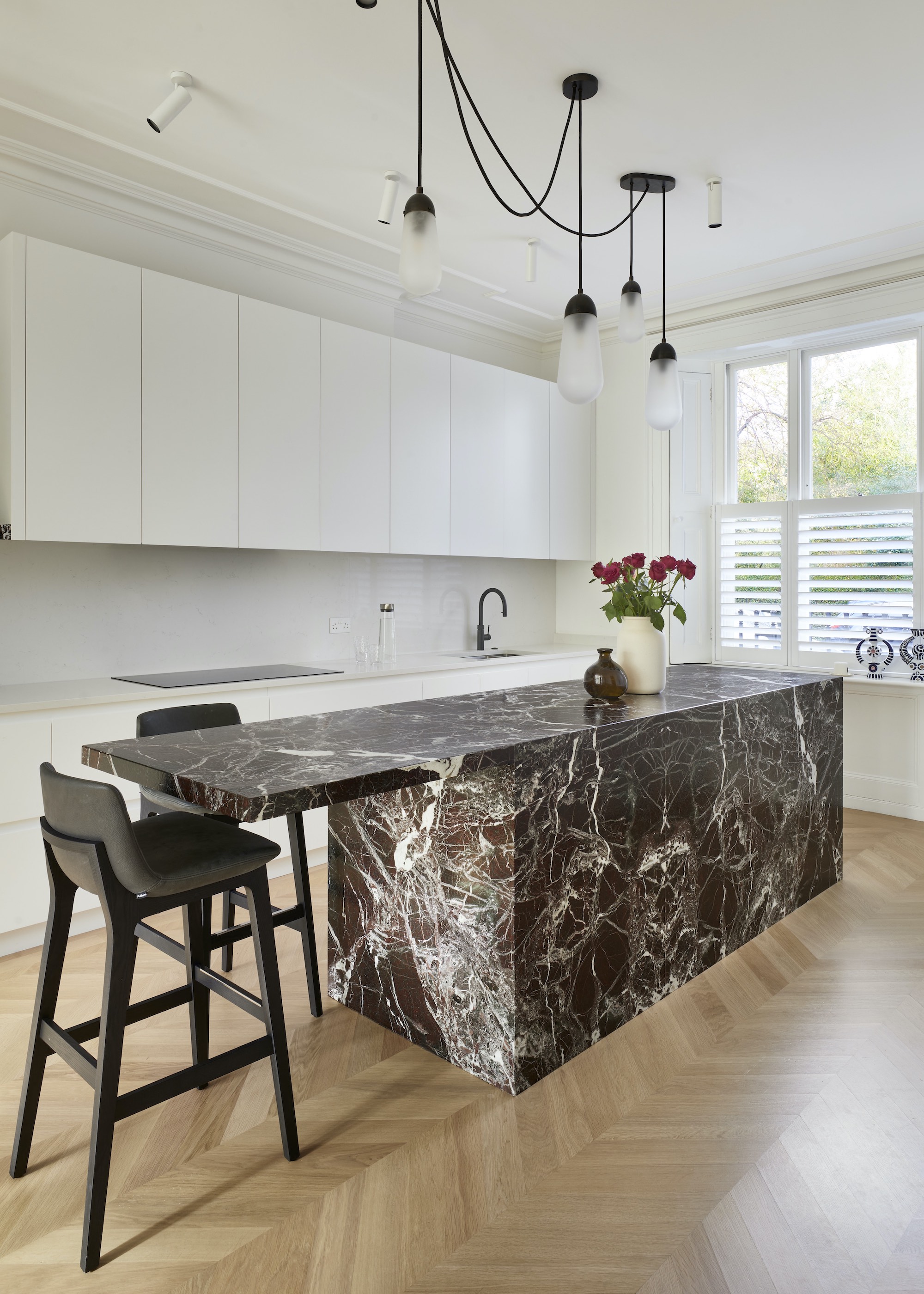
Looking for a different type of marble? Well, it seems white marble has reigned supreme for several years now, but if you’re after something a little extra, put dark stone on your radar. In this West London townhouse, the island is wrapped in Rosso Levanto, a deep burgundy marble with bold white veining and a leathered finish that softens the shine and adds depth.
“People often default to pale marbles, but darker tones can bring warmth and character without making the space feel heavy,” says Rachel Gower of Hetherington Newman. The key, she says, is balance. “We kept the cabinetry super clean and minimal so the marble could really stand out. Scale, finish, and tone are everything in this space. The textured surface not only looks more subtle than a high-gloss polish, it’s also more practical.” Eye-catching, tactile, and totally different, this deliciously dark marble island was a bold move, but it has definitely paid off.

Color: Red
6. Experiment With Thickness

This chunky island exudes design confidence and really shows off the marble’s incredible veining. Crafted in Arabescato Corchia, its layered, modular form creates the illusion of massive, stacked slabs. This marble island idea is sculptural, graphic, and a rock-solid conversation piece. “We wanted it to feel architectural, almost like a marble plinth in a gallery,” says Allison Lynch, Senior Designer, Roundhouse. “Playing with depth was key. The deep overhang adds visual tension and makes it feel less ‘kitcheny’.”
The chunky look is achieved by mitring thinner pieces of marble around a lightweight core, so you get all the drama of solid slabs without the weight, cost, or risk of cracked floors. “It’s not just a surface, it’s the anchor of the whole design,” adds Allison.
7. Coordinate the Color
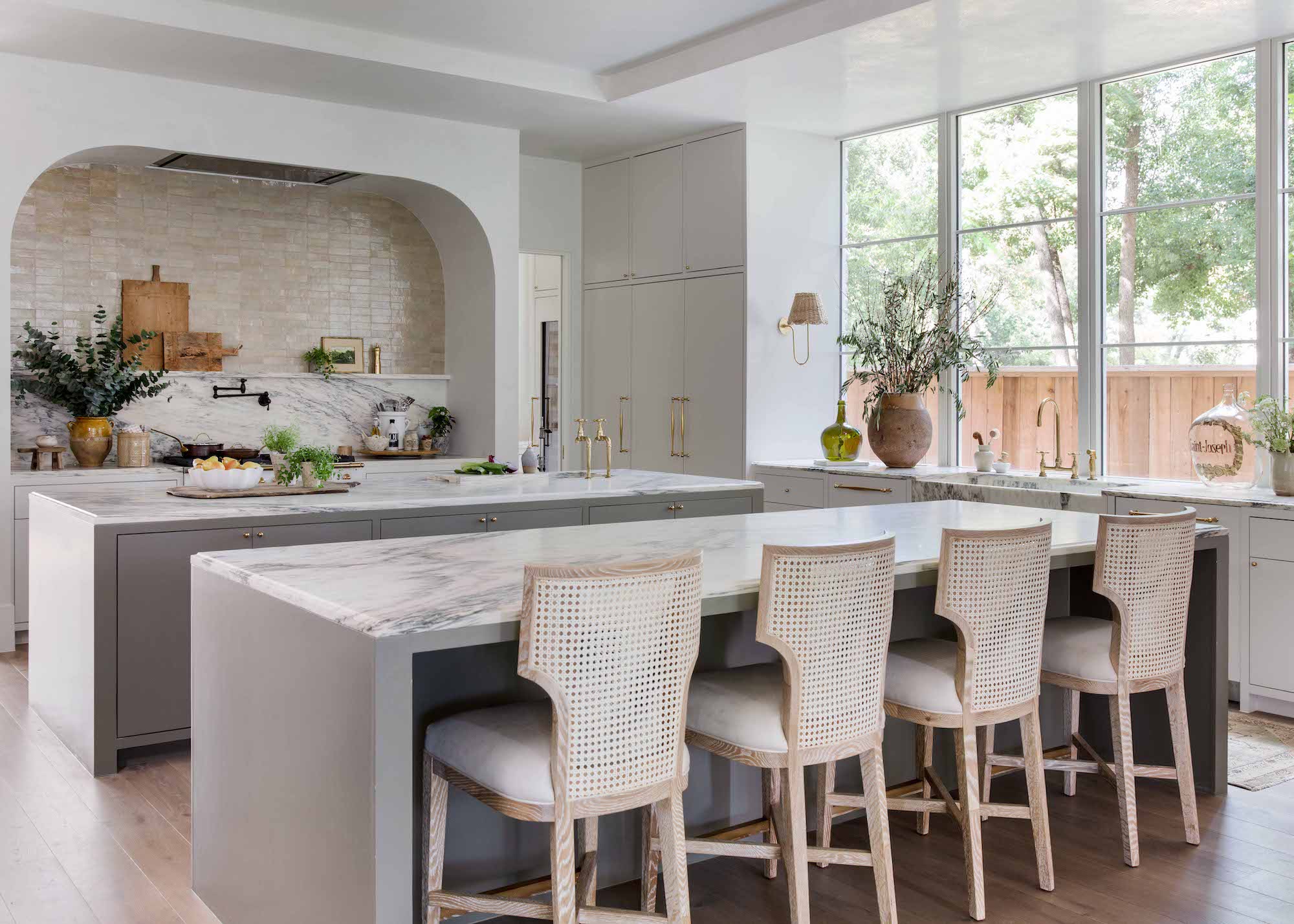
Get your priorities straight! Don’t choose your marble to match your kitchen; choose your kitchen around the beautiful natural colors in your marble’s veining. That’s exactly what Mimi Meacham, founder of Marian Louise Design, did for the kitchen in her own family home, and it has worked like a dream.
“The inspiration for the entire design actually came from the marble itself!” she says. “Early in the process of designing my home, I discovered a beautiful blush pink marble called Alabama Rose, and I absolutely fell head over heels.”
That dreamy stone sample became the moodboard. “I knew the colors needed to feel friendly and approachable to complement the open, airy floor plan and the abundance of natural light,” Mimi explains. Blush, grey-green, and ivory tones all flowed naturally from the marble’s palette.
But getting hold of it was a bit of a mission. “Alabama Rose is mined in a small, family-owned quarry in deep Alabama, and they weren't exactly in a rush to fulfil our order,” she recalls. Still, her persistence paid off. “When the countertops were finally installed, I cried happy tears. It was absolutely worth the wait,” she says.
8. Step It Up (or Down)

Flat marble island ideas are all well and good, but this split-level island design definitely steps things up a gear. Clad in Calacatta Manhattan marble, the island in this West London home creates a striking focal point that’s as practical as it is beautiful. “The aim was a statement piece with almost sculptural qualities guaranteed to impress guests,” recalls kitchen designer Sam Hart, of Roundhouse, who worked in collaboration with 23 Architecture.
Slim bronze inlays divide the marble planes, which appear to float thanks to a concealed steel structure beneath. The lower tier serves as a dining and working zone, a choice driven by ergonomics. “If an island is your only dining space, as was the case here, then it’s more comfortable to eat sat on dining chairs than bar stools,” explains Sam.
Other clever touches include hidden heat pads to warm the stone (kinder on skin when you sit down for breakfast), and a matching book-matched splashback that adds depth without stealing any of the island’s thunder.
9. Shake Up the Symmetry

A marble island doesn’t have to follow conventional forms. In her own home, interior designer Tamsin Johnson proves just how powerful a more unique silhouette can be. This stacked, asymmetric form is sculpted from Arabescato Vagli, delivering big on visual impact and pushing the kitchen firmly into art-gallery territory.
“We wanted some obscure lines to complement and offset the traditional style joinery,” explains Tamsin. The unexpected angles play beautifully against the classic cabinetry, giving the whole space a fresh, contemporary twist.
It’s this kind of confident, off-centre design disruption that brings energy and individuality to a kitchen. The marble’s rich veining and soft white base keep things feeling luxe and refined, while the form adds that creative edge. It’s a daring move for sure, but this marble island idea will certainly leave a lasting impression.
10. Take a More Practical Approach
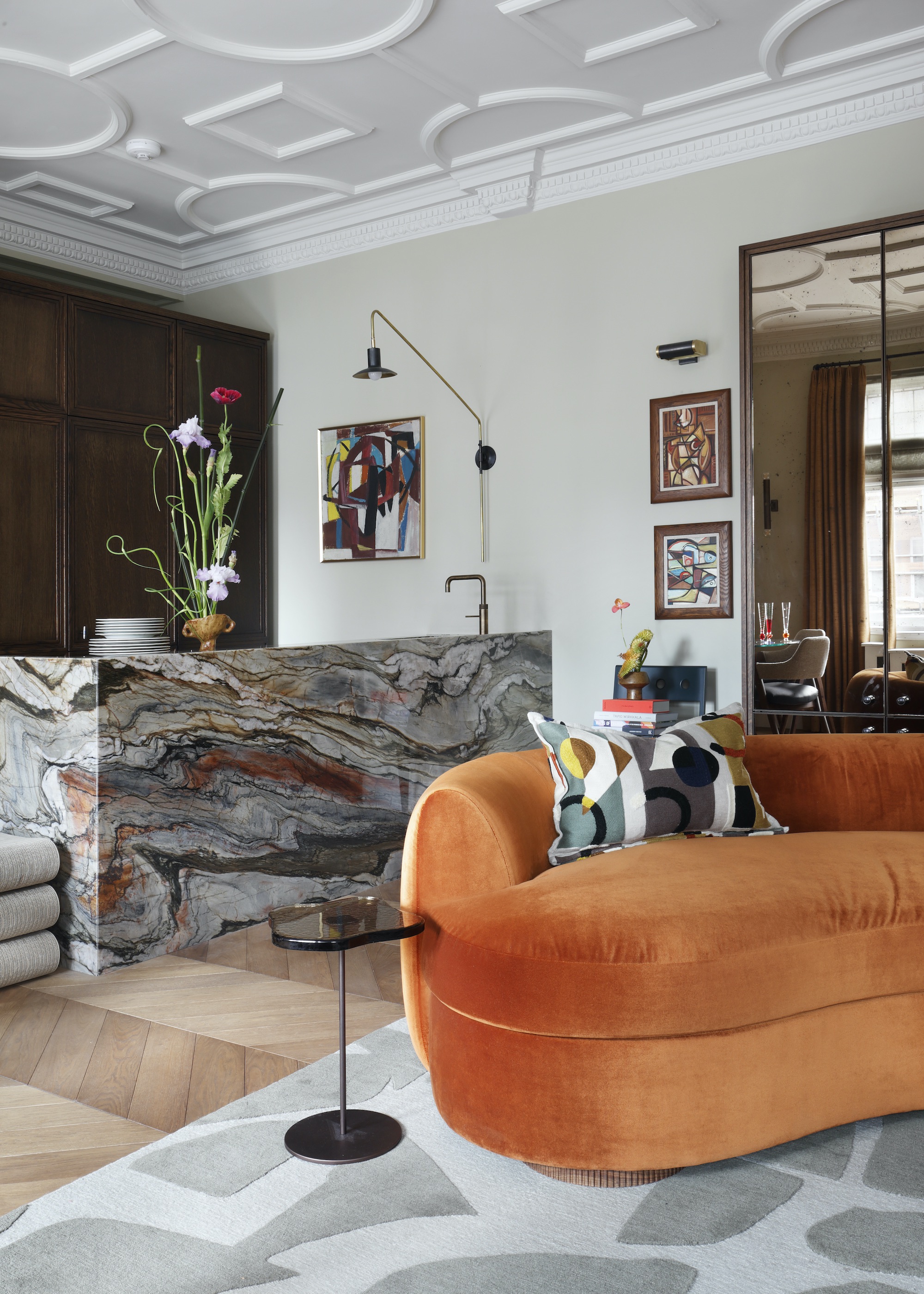
If you love the look of marble but are not excited by the thought of all the TLC required, quartzite might be your dream solution. Just as striking and unique — with those beautiful natural vein patterns you’ll never fake with manmade lookalikes — it also happens to be way more durable. Think less scratching, more stain resistance, and a finish that stands up to real life without requiring incessant resealing.
For interior designer Christian Bense, the switch from marble to quartzite was accidental, but it’s a pivot he’ll never regret. “As with art, we didn’t necessarily know what we wanted the marble on this island to be, we just knew that it needed to be special,” he recalls. “When we went to view slabs at the marble yard, we fell in love with this piece immediately, a quartzite called Tempest Blue, and it was just by coincidence that it matched beautifully with the blues, greens, and oranges in the rest of the room scheme.”
For the uninitiated, Quartzite is a natural stone formed from sandstone that's been fused by heat and pressure, making it incredibly hard and durable. “Quartzite is harder wearing than marble, and the colour variations in this type of stone are what now keeps us as a studio coming back to them,” explains Christian.
11. Bring It Forwards

Carrying the stone from your worktop down onto the front face of the island might sound subtle, but it will deliver serious design punch.
In this striking kitchen by Studio Doherty, it’s all about minimal moves with maximum impact. “We wanted to use the material palette to create a really simple scheme that was monochromatic yet quite dramatic,” says founder, Mardi Doherty. “The drama of this kitchen lies with its materiality, so we wrapped the island’s stone benchtop down the front — but instead of using a traditional waterfall edge, we kept the stone floating and ran the floor finish vertically up into it instead.”
The idea was to create a sculptural moment that plays with form and perception, grounding the island visually while keeping it feeling light, and, we think you’ll agree, Mardi has smashed it out of the park.
Kitchen Must-Haves
FAQs
Is Marble Good for a Kitchen Island?
As we’ve proved, marble island ideas can be a stunning choice that offers timeless elegance, natural beauty, and a sense of quiet luxury that is hard to achieve with other options. Its unique veining and colour variations mean no two slabs of marble are ever the same, which means marble can be used to make regular off-the-peg cabinetry feel totally bespoke and special.
However, you do need to appreciate the softer, more porous nature of marble and not lose your mind every time someone rests a glass of water on it without using a coaster. Some people will tell you that marble merely develops a natural patina over time, which sounds quite romantic. The reality is that it will be pitted with dull marks where acidic spills or even water have been left untended, it will chip on the edges, and it may well stain, too. At certain angles, with the sun on it, a marble top can look like it’s never been cleaned, even if you’ve just been buffing it for several minutes.
Yes, you can have it sanded back, and resealed (at least once a year, if not twice) and choosing a honed or leathered finish can help disguise the wear, but keeping marble looking nice requires time, money and energy. Basically, you need to go into it with your eyes open to all the pros and cons, and if you’re not willing to show marble the love it deserves, move along.
How Much Does a Marble Island Cost?
The cost of a marble kitchen island is a variable feast, and almost impossible to accurately pin down without getting a direct quote — having chosen your stone first. The size of the island, complexity of the design, any installation/delivery issues and of course the rarity of the stone itself will all have an impact.
Entry-level marbles like Carrara might start at around £300–£600 per square meter, while more luxurious stones like Arabescato or Calacatta can range from £700 to £3,000+ per square meter. Expect to need anywhere from three-to-six square meters for a standard size island, and a lot more if you’re cladding beyond the top surface. Fabrication and installation can range from around £800-£3k. If the slabs are particularly thick or heavy, additional structural support within the island (and even your flooring) might also be necessary, which will increase costs further.
Whichever way you look at it, a marble island is a serious investment. On the plus side, it will most likely outlive you!
Whichever type of marble you choose, there’s no denying marble forever brings the drama. But remember, the best marble island ideas aren’t just about the stone — they’re the ones that use marble in considered and interesting ways.







